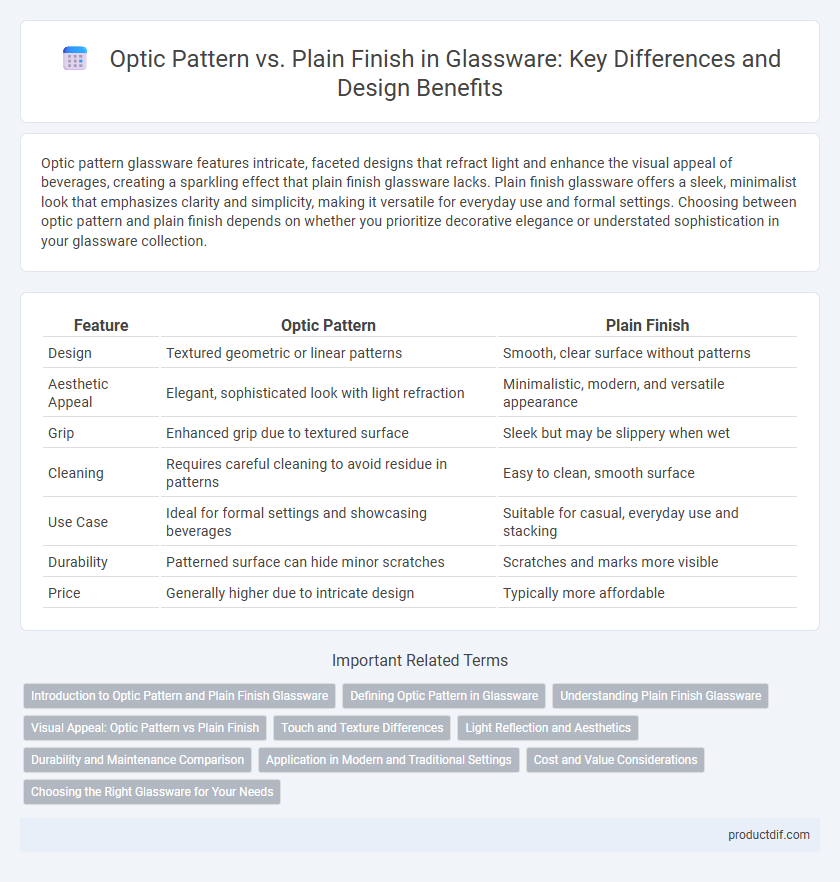Optic pattern glassware features intricate, faceted designs that refract light and enhance the visual appeal of beverages, creating a sparkling effect that plain finish glassware lacks. Plain finish glassware offers a sleek, minimalist look that emphasizes clarity and simplicity, making it versatile for everyday use and formal settings. Choosing between optic pattern and plain finish depends on whether you prioritize decorative elegance or understated sophistication in your glassware collection.
Table of Comparison
| Feature | Optic Pattern | Plain Finish |
|---|---|---|
| Design | Textured geometric or linear patterns | Smooth, clear surface without patterns |
| Aesthetic Appeal | Elegant, sophisticated look with light refraction | Minimalistic, modern, and versatile appearance |
| Grip | Enhanced grip due to textured surface | Sleek but may be slippery when wet |
| Cleaning | Requires careful cleaning to avoid residue in patterns | Easy to clean, smooth surface |
| Use Case | Ideal for formal settings and showcasing beverages | Suitable for casual, everyday use and stacking |
| Durability | Patterned surface can hide minor scratches | Scratches and marks more visible |
| Price | Generally higher due to intricate design | Typically more affordable |
Introduction to Optic Pattern and Plain Finish Glassware
Optic pattern glassware features intricate, geometric designs that enhance grip and refract light for a visually appealing effect, commonly used in cocktail and whiskey glasses. Plain finish glassware offers a smooth, untextured surface that emphasizes clarity and versatility, making it ideal for both casual and formal settings. Choosing between optic patterns and plain finishes depends on the desired aesthetic and functional use within barware collections.
Defining Optic Pattern in Glassware
The optic pattern in glassware features textured designs, such as ridges, bubbles, or geometric shapes, that enhance grip and visual appeal by refracting light. This patterned surface contrasts with plain finish glassware, which is smooth and transparent, offering a minimalist aesthetic. Optic patterns often improve durability and resistance to fingerprints while adding distinctive elegance to drinkware collections.
Understanding Plain Finish Glassware
Plain finish glassware features a smooth, unembellished surface that enhances the clarity and brilliance of the glass, making it ideal for showcasing the color and texture of beverages. Unlike optic pattern glassware, which has raised or etched designs that add grip and visual interest, plain finish glassware offers a minimalist aesthetic that complements various table settings. Its simplicity allows for versatile use in both casual and formal occasions, emphasizing the purity and elegance of the drink itself.
Visual Appeal: Optic Pattern vs Plain Finish
The optic pattern on glassware enhances visual appeal by creating dynamic light refraction and intricate textures that catch the eye, adding a touch of elegance and sophistication. Plain finish glassware offers a minimalist, sleek look, providing clarity and a clean surface that emphasizes the contents over design. Choosing between optic pattern and plain finish depends on the desired aesthetic impact--ornate and decorative versus simple and modern.
Touch and Texture Differences
The Optic pattern glassware features raised ridges and geometric shapes that provide a tactile, textured feel, enhancing grip and sensory experience. In contrast, Plain finish glassware offers a smooth, sleek surface that feels polished and minimalist to the touch, emphasizing simplicity over decorative elements. The distinct texture differences between Optic pattern and Plain finish glassware influence both aesthetic appeal and functional handling.
Light Reflection and Aesthetics
Optic pattern glassware features textured surfaces that refract and scatter light, creating dynamic reflections and enhancing visual appeal with intricate light play. Plain finish glassware offers a smooth, clear surface that allows natural light to pass through unobstructed, emphasizing transparency and minimalist elegance. The choice between optic and plain finishes impacts light interaction by either amplifying or preserving the glassware's clarity and aesthetic style.
Durability and Maintenance Comparison
Optic pattern glassware features raised lines or textured designs that enhance grip and reduce visible scratches, making it more durable against daily wear compared to plain finish glassware. Plain finish glassware, with its smooth surface, tends to show fingerprints and scratches more easily, requiring more frequent polishing to maintain clarity and appearance. Both types are dishwasher safe, but optic pattern glassware generally requires less maintenance due to its textured surface concealing minor imperfections.
Application in Modern and Traditional Settings
The Optic pattern glassware features textured surfaces that enhance grip and refract light, making it ideal for modern settings seeking a stylish, tactile element. Plain finish glassware offers a sleek, smooth surface favored in traditional settings for its timeless elegance and versatility. Both options serve specific aesthetic and functional roles, with Optic patterns emphasizing design innovation and Plain finishes highlighting classic simplicity.
Cost and Value Considerations
Optic pattern glassware typically costs more than plain finish due to the intricate designs that add visual appeal and enhance grip, increasing manufacturing complexity. The added texture of optic patterns often justifies a higher price point by providing improved aesthetics and functionality, offering better value for events needing elegance and safety. Plain finish glassware remains a cost-effective choice for everyday use, delivering simplicity and ease of cleaning but lacking the premium feel and decorative impact of optic designs.
Choosing the Right Glassware for Your Needs
Optic pattern glassware features raised designs that enhance grip and create a visually appealing texture, ideal for casual settings and adding tactile interest. Plain finish glassware offers a smooth, minimalist look that suits formal occasions and highlights the clarity of the beverage. Selecting the right glassware depends on the intended use, aesthetic preference, and the type of drink served to ensure both functionality and style.
Optic pattern vs Plain finish Infographic

 productdif.com
productdif.com